Twenty Summits of Mt. Everest but…there’s more to Apa Sherpa than his world record
By Rick Shandley and Kimberlee Frederick
Photography: All Marshall Thompson images, and others, are attributed to the Apa Sherpa Foundation
“Everest is never easy. Every time it is hard. This time it was just as difficult as all the others.” That’s what Apa Sherpa said when asked whether his latest summit of Mt. Everest was any easier than the 19 Everest summits he already survived.
Much has been documented about Apa Sherpa. His 20 summits of Mt. Everest as of 2010, stand alone. However, Apa Sherpa is a humble human being who is driven, not by Mt. Everest, but his beloved people of Nepal and the country itself.
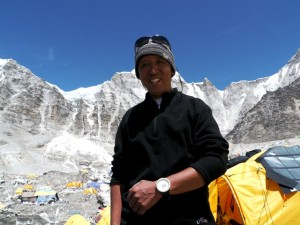
“Nobody knows much about Nepal, but everybody knows about Everest,” Apa Sherpa said in a recent interview with Fresh Air Junkie. His goal for that historical 20th summit was to use his accomplishments as a way to get the word out about important causes he is determined to move forward. His priority for 2010 is to provide education for children, care for the mountain, and clean up the environment. “My goal is better education,” he said.
“The reason I’ve done this 20 times is because I’d like to help education in Nepal, he said. Also, I want to clean up the environment. We need to get the mountain clean.” Although Apa Sherpa, his wife and children now call a little hamlet near Salt Lake City, Utah home, he has never forgotten the challenges of growing up in poverty and disadvantage.
But instead of resentment, he channels his kind nature into the possibilities he can work towards in order to effect positive change. It’s kind of like dreaming of the challenge of climbing Mt. Everest, and then doing it…twenty times. Apa Sherpa changed his own life by becoming the best. Now he seizes upon his acclaim to make life better by giving his best to his fellow Sherpa.
Apa Sherpa Foundation
On March 28, 2010, the formation of the Apa Sherpa Foundation was completed. But for many years, decades in fact, Apa Sherpa has dedicated himself to helping his Thames, Nepal home village, his countrymen, and champion educational opportunities for Sherpa children.
The Foundation strategy is to encourage children to learn about their Sherpa culture, their country, and the educational opportunities to work, support their families, and participate in a thriving homeland. Teachers and individuals that will share knowledge and instruct youngsters are core factors in order to build upon and disseminate the Foundations goals at home, and radiate outwards from there. “This year, education is number one. Without education, there is no choice. We have very poor education in Nepal, and I’d like to help with that.” Included in this desire is to help the young men and women of Nepal to use their education and talents to help their native land to thrive, rather than leave for some distant country and another way of life.
The State of the Mountain
Receding glaciers and snowpack is evident on Mt. Everest, and so is the discarded remnants of previous expeditions. Apa works with his Sherpa countrymen and individuals from around the world to climb, retrieve, and pack the flotsam and jetsam of high-elevation conquest of expeditions gone by. There’s still a lot of work to do to free Everest of the garbage, but Apa and many people continue to police the mountain.
Up on the mountain this year, the 2010 Everest expedition took almost two months. “It was not only for climbing, we cleaned as we
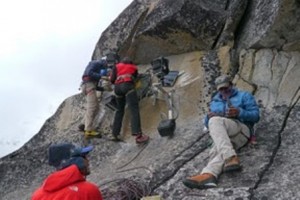
went,” he said. In all they packed out about 12,000 pounds of garbage. “I joined Eco Expedition for the last three years,” he said. “Every year we clean up, but every year there is more and more garbage,” Sherpa said. In no way is this observation a slight on the mountain, but a situation that is being addressed with passion. It’s an uphill climb to get all the oxygen bottles and hardware left on the mountain, but it’s something that will get done as subsequent Eco Expeditions benefit from more volunteer climbers and more awareness to reduce artifacts left behind by future climbing parties.
Just prior to his summit climb for 2010, Apa Sherpa went up on Everest a few days early to retrieve a different type of remnant from the mountain. This climb was to retrieve the human remnants of climbers who lost their lives to Everest. The locations of dead bodies are sometimes known. Sometimes they become visible as snowpack recedes. Some bodies have laid in-state within the ice for decades, only to reappear at the bottom of the Khumbu Ice Fall. Each body of a deceased climber that is recovered is regarded with the honor and dignity all human beings deserve. This year the search and recovery climb team was able to bring down three bodies; all to eventually be reunited with family, country, and a proper internment.
Sherpa also noted that big changes in the temperature have had an impact on the mountain. More exposed rock, less snow and ice on sections of the mountain that used to be frozen since man’s beginning. “It’s “more rocky now,” he said. Receding glacier is occurring around the globe. Science wants to understand it. What’s gone is gone. Yet, if there are solutions to prevent this, Apa Sherpa and his fellow mountaineers want people to tank-up on education and participation that might lead to further erosion and a warming trend that bodes ill for humanity.
Although Apa Sherpa has seen many changes on Mt. Everest, the challenge of the 2010 climb is no less or no more daunting. There were, “no new challenges, but it’s not easy,” he said. Perhaps it takes a day less for Apa to become accustomed to the higher elevations, but the dangers of the mountain continue without pause. And though his 20 Everest summits set him apart, Apa Sherpa would love to see others from his country excel beyond his high-water mark.
Alpa Sherpa and Suunto
At any elevation along the upper reaches of the 29,029 foot Mt. Everest, reliance on a mountaineering watch for compass bearings, elevation, weather information, and temperature is a matter of life and death.

In regards to one of his major sponsors and partners in his venture to educate and improve lives, Apa Sherpa considered Suunto and the precision instruments that he relies upon on his journeys above tree line. “There’s a lot of watches, but not like a Suunto watch,” he said. And he has had to rely on plenty of expedition-grade timepieces. Speaking about the Suunto CORE, Apa gave us his take: “It has a lot of functions, and all of them are important for climbing.
Functions like alarms must not only wake the climber up, but they must signal the “death zone” and benchmarks along the route to provide the climber with critical information. “I know there are many watches, but none of the watches I have are like a Suunto. I’ve used (Suunto watches) since 2003.”
Often times the information the climbing party observes with their eyes are also corroborated with readings provided by the climber’s on-wrist timepiece, barometer, altimeter, and bar-chart graphics. Armed with this level of information, the climbers must assess their situation and make go, no-go decisions about the climb at any level of the overall attempt.
And to commemorate his world record of 20 Everest summits, Sunnto built a watch in Apa Sherpa’s honor, the Suunto Core Extreme Edition Everest. Only 8,848 Sunnto CORE high-altitude expedition watches will be produced, one for every vertical meter that represents the height of Mt. Everest.
Any fund raising activity Apa Sherpa is involved in contributes to the operations of his foundation. So there will be many potential revenue streams by which the Apa Sherpa Foundation can do more. “In the future, we’d like to raise even more money for the environment, but right now the focus is on education.”
Apa Sherpa: Future Plans
For a gentleman who, at age 12, began his journey into the heights of the Himilaya’s hauling mountaineering gear and learning his
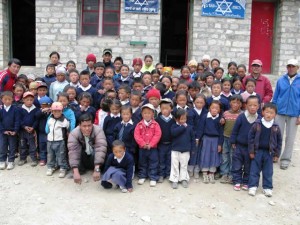
profession, one might wonder what the future holds for Apa Sherpa. He has survived 20 expeditions to the top of the world. He would have his fellow Sherpa beat his world record. He only wants to help the youngsters of his homeland benefit from education as his own children in Utah. Apa Sherpa’s passion for speaking about climatic changes and the ruthless effects on the Himalaya Mountains and its people have presented him new challenges and new opportunities to speak for his people, and to the people of the world who will hear his words.
In October, Apa Sherpa heads to Canada to raise money and speak about the issues he wants to do something about. He plans to continue giving speeches about his culture, his causes with education, and about Mt. Everest, and his many summit experiences.
Looking down the trail, Apa Sherpa hopes to spend time trekking, writing books and raising funds for his causes in Nepal. On this front his target is still about the children. “My focus is raise money to help with education.”
But what about tagging the big peak one more time? Is there a 21st ascent to the cloud enshrouded heavens around Mt. Everest in Apa Sherpa’s plans for 2011? “I have not decided yet. We have plenty of time. Maybe I will, maybe not,” he said. “If I don’t climb, I’m going to write a book.”
Learn and Participate at: www.apasherpafoundation.com and www.apasherpa.com


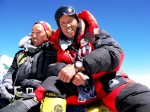




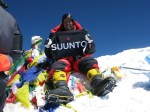

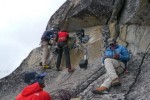
Pretty cool. I love see stuff like this. Keep up the good info!